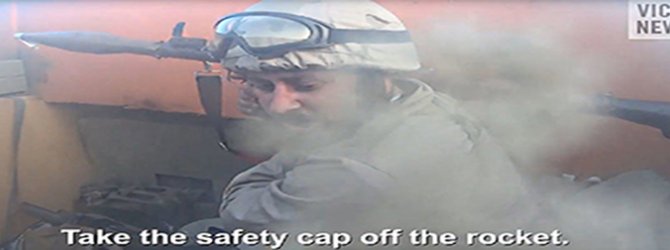-
The Head-cam Video Daesh Doesn’t Want You to See
The Head-cam Video Daesh Doesn’t Want You to See

You may have seen the Daesh helmet-cam video released by VICE on April 27, titled What It’s Really Like to Fight for the Islamic State. Contrary to the slick content pushed out by the Daesh media machine, this video reveals what life is really like for Daesh fighters on the front lines – and the picture is grim. However, narratives like these could be the best counter-mechanism to discourage people from joining Daesh, and thus an effective tool to combat radicalisation.
According to Vice the footage is “taken from the headcam of an Islamic State fighter who died battling the Peshmerga in Northern Iraq.” The video details the battle, as Daesh fighters, manning an improvised armoured vehicle, descend upon a Peshmerga location some 30 miles North from Mosul. Among the fighters is Abu Hajaar – and you learn his name pretty quickly, because it is repeated by his fellow fighters numerous times as they admonish him for his ineffectiveness.
“No, Abu Hajaar watch out! The bullet casings are hitting us!” a fellow fighter yells at him, after asking Abu Hajaar to provide cover. “What’s wrong with you, Abu Hajaar?” screams one of the fighters in another instance. There is disarray as the fighters scramble to pick up and fire different weapons.
This video can tell us a number of things about Daesh. First – and this is something many of us have suspected – life as a Daesh recruit is not as glorious as they make out in their propaganda. In this video the fighters are frenzied and disorganised. The basic military training that is provided to recruits doesn’t appear to have been sufficient as two of the fighters’ performances in particular – Abu Abdullah and Abu Hajaar’s – are unimpressive to say the least. There is confusion about how weapons should be used.

Vice News Images
Also telling was the outpouring of online responses to the Vice video. Abu Hajjar became a meme, with twitter users both pitying him and mocking him. Al Bawaba published an article titled “Daesh fighter becomes new face of global incompetence” while BuzzFeed came to his defense asking “Who among us hasn’t been Abu Hajaar at some point in our lives?”
Daesh propaganda aims to instill fear and awe, and in the group’s own media, Daesh is depicted as a formidable fighting force. However with their memes and tweets, internet users have deconstructed Daesh narratives. Their humourous mash-ups make reference to other well-known failures and generally depict Abu Hajaar and his comrades as hapless and non-threatening – one Twitter user mocks their rolling strategy (after their vehicle is hit) by comparing them to summersaulting pandas.
Watching the video I was reminded of an article I read on the Guardian about “Abu Ali” – a Daesh recruit who was told he was going to be working in administration for Daesh, but ended up on the front lines. He was forced to participate in a futile battle which he described as 12 Daesh recruits pitched against the Iraqi army. They initially wanted Abu Ali to man a heavy machine gun, but he didn’t know how to operate it, and so he was relegated to the medical team. In the resulting battle, many of his comrades were injured or killed. Like the Vice video, Abu Ali’s story reveals how inexperienced some Daesh fighters are, and the disregard the group has for the lives of their own soldiers.
Stories like the Vice helmet-cam video and Abu Ali’s account could be the best way to prevent people from leaving to join the group. First hand accounts of life as an Islamic State ‘citizen’ or fighter expose the truth about the group. Other such accounts have detailed infighting between Sunni groups and expose the banality of life in Caliphate – revealing that for many, the concept of a “fivestarjihad” is a fallacy. These are the stories that we hear so infrequently. Collecting such evidence is challenging, because of a lack of access to fighters or returnees who can share their stories.
The Daesh head-cam video was probably intended as propaganda – but it massively backfired. It exposed the choreographed nature of the group’s other video production. Bruce Jackson has said that “for governments at war, the media is an instrument of war or an element in war that is to be controlled.” The same could be said for ‘pseudo – states’ like Daesh. Previously, they projected power through their savvy use of new media. However, with the Vice video, Daesh lost control of the narrative.
This is the video Daesh does not want you to watch. For that very reason, you should definitely watch it.
Note: It’s worth touching on a few points related to accuracy. One blog has identified that the Vice video is actually the combination of a number of videos, and commented that the date given by VICE was inaccurate, and the attack occurred in mid December 2015.

